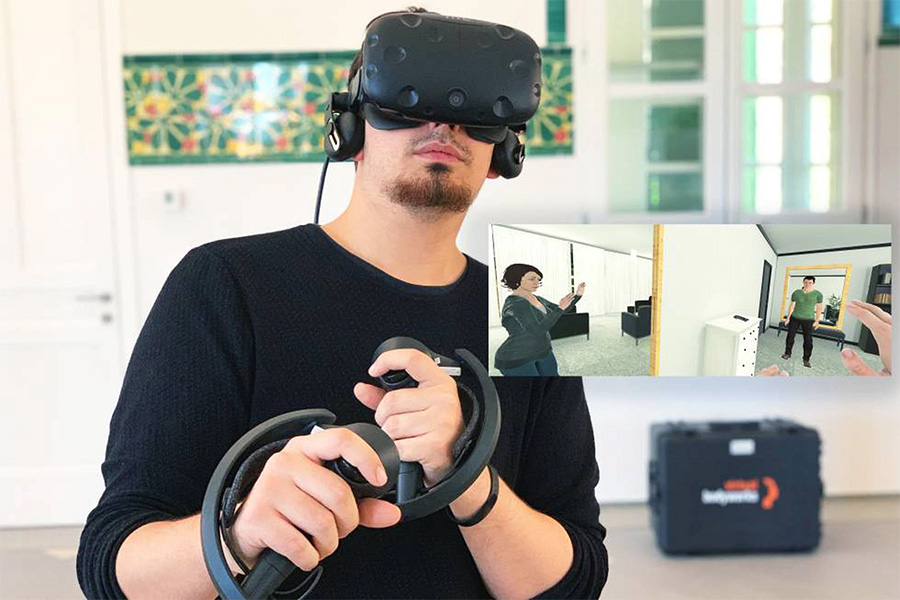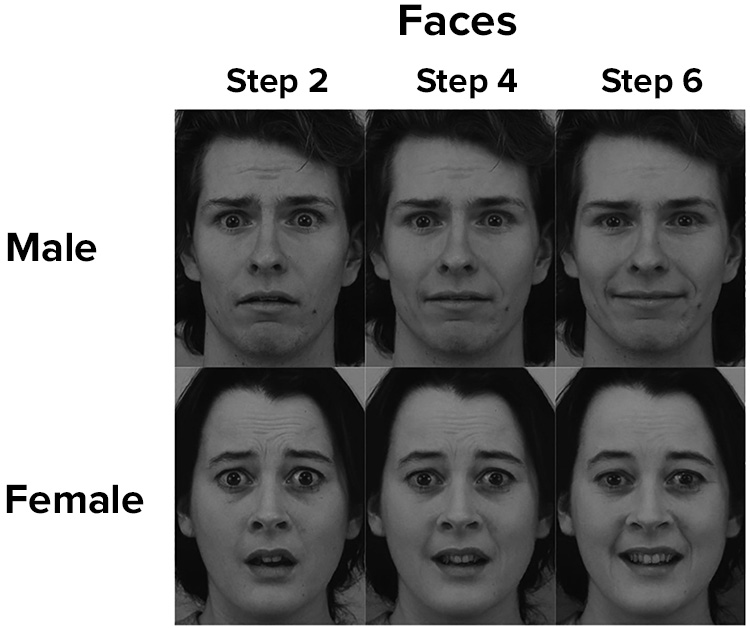“I have to come home every day and look at your shitty face,” the man barks to his partner. “When we married, you were hot. Look at you now. You look like shit.” The man advances, knocking the phone to the ground, until his face looms menacingly close.
This harrowing scene is not what it appears to be. The victim isn’t a real person — she’s the virtual reality avatar of a man already imprisoned for domestic abuse. The scenario is unfolding, in 3D, inside a VR headset strapped to the prisoner’s head. And it’s part of a novel intervention. The idea is that by experiencing domestic abuse through the eyes of the victim, abusive men might gain some insight into their acts — and empathy for the women.
Some new ideas for rehabilitating abusers would certainly be welcome: Domestic violence affects about a third of all women at some point in their lives, according to the World Health Organization. And while some jurisdictions require people convicted of domestic violence to participate in intervention programs, there is limited evidence that these treatments prevent offenders from harming their partners again.
Virtual reality can give participants the illusion of being in a different body. This video shows how researchers create this illusion and then use it to put men in the body of a female victim of domestic abuse.
CREDIT: S. SEINFELD ET AL / SCIENTIFIC REPORTS 2018
That’s where virtual reality might help, say the researchers behind this approach. When combined with traditional techniques that psychologists and social educators use to enable abusers to understand their behavior from the perspective of the victim, they say, the VR intervention could make existing programs more effective.
Already, authorities in some parts of Spain have integrated this VR exercise into their prison-based intervention programs for batterers, and researchers in Finland are beginning to examine it too. But does it make a difference? The evidence, while scant, looks promising so far.
Standing in the victim’s shoes
The virtual reality tool exploits the brain’s constant efforts to maintain awareness about its body and that body’s whereabouts. “Our whole lives, when we look down towards ourselves, we see our body move. If I look at my hand, and I move it, it’s my hand I see move,” says Mel Slater, a computer scientist at the University of Barcelona in Spain who is part of the team that developed the abuse scene. By meddling with the sensory inputs the brain receives, VR can manipulate this body image.
The abuser wears a head-mounted display and two hand units that detect his posture and body movements. As a result, the 3D female avatar that the abuser “becomes” in the virtual scenes will mimic his movements exactly: If the user raises his hand, for example, the avatar moves her hand too. Mirrors inside the virtual room also allow the user to see the reflection of this virtual self, completing what researchers call a “full body ownership illusion,” in which the brain makes sense of the inputs by assuming that this female form is, indeed, its body.
“You know it’s an illusion, but that doesn’t stop it from happening,” says Slater. Virtually, the abuser now exists in this female body, and is watching the events unfold from her perspective.
The experience of being virtual victims affects the men profoundly, says Nicolas Barnes, a forensic psychologist who works in Spain with the Catalan justice department’s rehabilitation program in prisons. “Normally, when the perpetrators start a session, a lot of them think that it’s a sort of game,” he says. “But when they are into the scene, they are impacted. Some perpetrators cry.” Some of the attendees have told Barnes after a session that they feel ashamed of their behavior and better understand its negative impact on their family. Six Catalan prisons are now using the tool, and the plan is to expand its use across Catalonia.
Promising hints
Putting VR headsets on convicted criminals to improve their emotional skills may seem a bit outlandish, but virtual reality already has a strong track record in the field of mental health. Studies have shown, for example, that when therapists treat people suffering from fear of heights by gradually exposing their patients to the fearful stimuli, virtual reality-powered exposure therapy is nearly as effective as conventional exposure therapy. VR-based applications are also being used successfully in the US to alleviate symptoms of post-traumatic stress in veterans.
In 2010, a team of researchers led by Slater and Mavi Sanchez-Vives, a neuroscientist at the August Pi i Sunyer Institute of Biomedical Research in Barcelona, began applying this technology to the field of domestic abuse intervention. They developed their VR tool after consulting extensively with gender violence experts to learn about domestic abusers and how batterer intervention programs work. The researchers first tested the VR scenario with men not implicated in domestic violence, and later started using it with domestic abusers who had been required to attend a rehabilitation program as a condition of their probation.

A person demonstrating the virtual-reality gear required for the domestic abuse simulation. A headset shows the simulation, which changes to track the direction of gaze as the person moves his head. The hand controllers detect hand movements so that his virtual body’s hands make the same motions within the simulation. Together, these create a strong illusion that the man’s virtual body is really his own.
CREDIT: PHOTO BY SAMEER KISHORE, VIRTUAL BODYWORKS
In one study, the scientists tested the abusive VR application on 20 domestic abusers and 19 men with no history of intimate-partner violence. Before and after experiencing the simulation, the participants took a computer-based emotion recognition test in which they were asked to identify emotions such as happiness, fear and anger on faces. At first, the offenders had a harder time classifying emotions correctly than the non-abusers, the researchers found — in particular, they were more likely to identify fearful expressions as happy. This fits with previous research finding that violent individuals tend to lack empathy and process others’ emotions poorly, and that this can contribute to their violent behavior.
After encountering the violent male avatar inside the headset, though, the abusers were able to identify expressions of fear in women with more precision. “When they’re put in the situation, that they themselves are now being abused by someone else, in the body of a woman, it’s like they experience this kind of fear themselves,” Slater says. In a follow-up study on prisoners, Barnes used a standard questionnaire and a computer-based emotion recognition task to measure empathy in about 60 abusers before and after the VR intervention. The study, which isn’t published yet, found that empathy levels improved after a single session, Barnes says.
“It’s an experiential thing, not only a cognitive thing,” says Barnes of the VR tool — and therein lies its power. Psychologists and social educators who work with abusers in rehabilitation efforts can explain the concept of empathy to prisoners, but virtual reality allows the perpetrators to actually feel it, he says. Barnes adds that he can also show offenders a similar scene from the viewpoint of a child watching the abuse, helping the men to consider the effects of their actions on their kids.

Violent criminals tend to lack empathy, which makes them poor at recognizing emotions in others’ faces. Here, researchers have used computers to morph facial expressions on a 9-step continuum from fearful to happy (steps 2, 4 and 6 are shown here). After experiencing a virtual reality simulation as the victim of domestic abuse, offenders had improved ability at classifying the facial expressions.
CREDIT: ADAPTED FROM S. SEINFELD ET AL / CORTEX 2021
What happens in the brain when people are immersed in these violent VR scenes? A 2020 brain imaging study by Sanchez-Vives, Slater and colleagues provides some clues. Before and after experiencing the VR simulation, participants watched emotional expressions that changed from fearful to happy while they were inside a brain scanner. After the VR immersion, the participants’ default mode network — a network of brain regions involved in reflecting about the thoughts and emotions of others, among other functions — lit up significantly when the subjects looked at vague emotional expressions, a sign that they were processing them more deeply.
So far, much of the evidence to support the success of the VR approach comes from lab studies like these. It’s hard to measure the tool’s real-world impact, the researchers say, because European Union data protection laws make it difficult to follow up with people who finish these programs, or with their partners to see if the abuse has stopped.
But a few years ago, the researchers were able to obtain some preliminary data about 184 offenders on probation who had taken the VR intervention during their rehabilitation program. Four years on, only 2.2 percent had been re-arrested, compared to 6 percent among 177 men who had participated only in the standard rehabilitation program. Slater notes that the study hasn’t been peer reviewed and the finding isn’t strong enough to yield firm conclusions about the VR treatment. But, he says, “at least it went in the correct direction.”
In the meantime, the technique is spreading. Finland’s University of Jyväskylä Psychotherapy Training and Research Centre is currently preparing to test the same VR simulation with abusers who voluntarily attend its intervention program. In addition to measuring levels of empathy, the Finnish researchers will use measures such as heart rate to see how the experience affects individual batterers.
Broader application
Experts who study crime and violence eye the VR strategy with interest and optimism. Claire Nee, a forensic psychologist at the University of Portsmouth in the UK who studies criminal behavior using virtual reality, says it’s an exciting technology. “I see VR as a real step change in helping people to desist from crime,” she says. But for the approach to be adopted widely, she adds, more data will be needed to show that it reduces repeat offending. “That’s the thing that’s going to definitely convince governments and policymakers that this is worth doing,” she says.
Many offenders possess a general sense of right and wrong but learn to justify their acts over time, says criminologist Volkan Topalli of Georgia State University, who coauthored an overview of research on criminal offenders in the 2020 Annual Review of Criminology. “This will be very valuable for dealing with offenders who we know have a moral center, but are very good at defeating that moral center,” he says. The approach may also be useful as a screening tool, he adds, to identify which offenders are capable of empathy and which are not.
In time, says Dominic Parrott, a clinical psychologist at Georgia State who studies aggressive behavior, researchers might be able to use the technique to create VR interventions tailored to particular groups of offenders. “Violence is a very multifaceted behavior that’s caused by numerous different factors,” he says. So people who become violent only when they are drunk may need a VR scenario that helps them to understand how alcohol influences their behavior and how their abuse affects others. An abuser who is primarily a controlling type may benefit from an immersive environment that plays out control scenarios in relationships to help them realize the nature of their abuse.
Already, Sanchez-Vives and her team are gearing up to use novel immersive VR scenarios to target other sociocultural contributors to domestic violence. There’s one in the works for college students to address unhealthy relationship behaviors and dating violence; there’s another intended for visitors to museums and civic centers to create awareness about issues such as victim-blaming. Domestic violence, she says, “is a problem that has to be treated from many different fronts. It is very complex. It is very embedded in society.”




